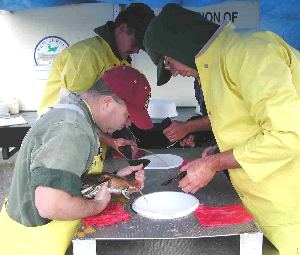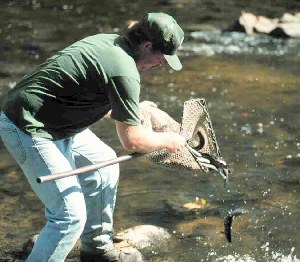Twenty Years of Trout Production at PequestHatchery Superintendent March, 2002 It was 1982 when a turning point for the Division of Fish and Wildlife's Bureau of Freshwater Fisheries was reached - the Pequest Trout Hatchery began production. Since then the division has consistently produced 600,000 quality brook, brown, and rainbow trout annually as a result of modern technology and a high quality water supply. Clean, moving, cold water is a key factor that is essential to the success of a trout rearing facility.
Pequest began operations with the Division securing more than one million trout eggs of three different species. The eggs came from pathogen-free hatcheries, the first step in developing a trout raising program free of disease. Rainbow trout eggs were obtained from West Virginia, and brook and brown trout eggs from Massachusetts. From the first hatch fish were hand-selected to serve as broodstock, and to this date a quality broodstock population is maintained at the hatchery to serve as an "in house" egg source.
The production cycle begins in early fall when hatchery staff manually strip and fertilize eggs from adult broodstock. The eggs are then placed in continuous cold-water flow incubators for twenty eight to thirty five days.
Upon hatching, the sac-fry (as the hatchlings are called) are moved from the incubators to special tanks in the nursery building. After a three month growing period, the fry (now called fingerlings) are sorted for size. In March, as the previous year's trout are stocked and room becomes available, the fingerlings, are moved to a series of outside pools known as raceways. There are 8 "lines" of raceways which would total more than a mile in length if laid end to end.
After the summer growing period the fish are again sorted for size and left in the raceways to obtain a 10.5" average length by the spring season. By mid-March, with another generation of trout growing in the Nursery Building, the hatchery trucks are rolling.
Quality trout are stocked in over two hundred lakes, streams, and rivers for the benefit of anglers statewide. During stocking, excess and older broodstock are liberated along with the regular production stock. These fish range from fifteen to twenty inches and average three to eight pounds.
After twenty years of successful production at the Pequest facility other stocking programs have been added. The fall, winter and sea-run programs were scheduled into the production cycle to increase the recreational opportunities for anglers. Now the division offers sportsmen and women quality, catchable-sized trout throughout the fall and winter months in addition to the traditional spring season. Our success and funding base for the past twenty years can be attributed to all of the freshwater anglers who purchase fishing licenses and trout stamps. The Division of Fish and Wildlife is looking forward to providing you with a quality trout for the years to come. Learn more about Pequest. |
||
|
||
|
|
||
|
||
| |
||

 On the hatchery grounds within the 4000-acre Pequest Wildlife Management Area are six production wells that can supply up to seven thousand gallons per minute. The continuously flowing waters of Pequest are a constant 52 degrees Fahrenheit.
On the hatchery grounds within the 4000-acre Pequest Wildlife Management Area are six production wells that can supply up to seven thousand gallons per minute. The continuously flowing waters of Pequest are a constant 52 degrees Fahrenheit.


